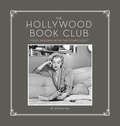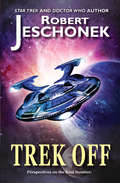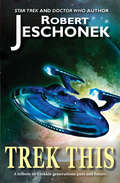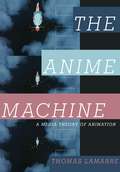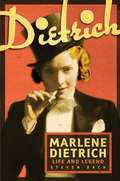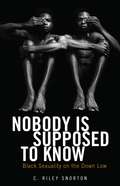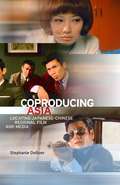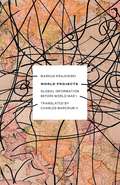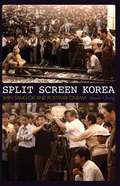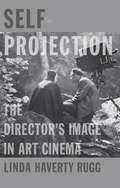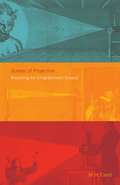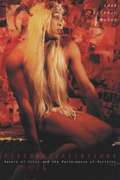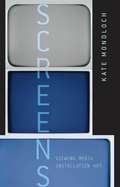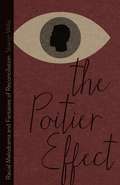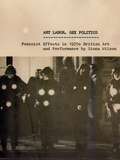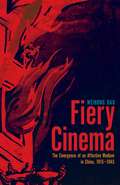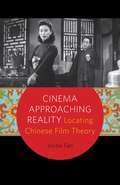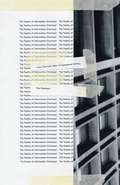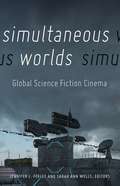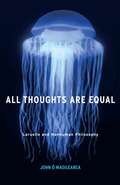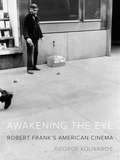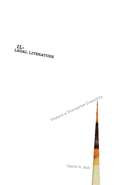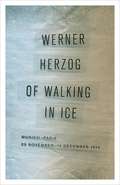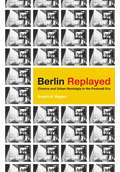- Table View
- List View
Hollywood Book Club
by Steven ReaAudrey Hepburn, Humphrey Bogart, Gregory Peck, Rita Hayworth, Marilyn Monroe—the brightest stars of the silver screen couldn't resist curling up with a good book. This unique collection of rare photographs celebrates the joy of reading in classic film style. The Hollywood Book Club captures screen luminaries on set, in films, in playful promotional photos, or in their own homes and libraries with books from literary classics to thrillers, from biographies to children's books, reading with their kids, and more. Featuring nearly 60 enchanting images, lively captions about the stars and what they're reading by Hollywood photo archivist Steven Rea, here's a real page-turner for booklovers and cinephiles.
Trek Off!
by Robert T. JeschonekCaptain Picard, Commander Riker, and Lieutenant Data made history on the bridge of the Enterprise in Star Trek: The Next Generation...but what about the crewmen of the lower decks?Captain Sisko, Commander Worf, and the crew of Deep Space Nine were posted on a space station...so how did time travel become such a big part of their greatest adventures?What was the key to the Starship Voyager getting home safe and sound from the Delta Quadrant? Is Captain Kathryn Janeway the greatest of all Star Trek captains because of her decisive command style?Find the answers to these questions and more in Trek Off! In this collection of short essays, award-winning Star Trek writer Robert T. Jeschonek explores the worlds of Trek, from The Next Generation to Voyager. Join him on a journey through time and space in a search for the secrets of the Trek universe.This volume, a tribute to the greatest science fiction epic of our age, includes four essays: "Lower Decks," "Past Tense," "Final Authority," and "To Boldly Go Where No Comic Book Has Gone Before: 10 Star Trek Comic Book Lost Treasures." These essays are collected here for the first time.Robert T. Jeschonek knows his Trek. He won the national grand prize in the Strange New Worlds writing contest. He is one of a handful of authors chosen to write stories in the Star Trek: New Frontier universe. His latest Trek fiction appears in Star Trek Corps of Engineers: Out of the Cocoon. Now he invites you to ponder some of the cool questions of Trek, explore some exciting lost comic book treasures, and boldly follow in the footsteps of the legion of Trek fans who have gone before.
Trek This!
by Robert T. JeschonekA twisted Trek-stravaganza from an award-winning Star Trek author!Seven stars of a science fiction universe warp through twisted changes on the final frontier. Driven by forces they can't understand, the magnificent spacefaring Seven charge through bizarre transformations and battles beyond imagining. Each victory leads to fresh conflict, but the truth remains out of reach. With no memories of the past, how can the Seven recall their true identities? Only a mischievous, all-powerful being from beyond the stars seems to hold the answers. But will his amazing revelations open the gateway to illumination...or death? The power of the Seven may hold the ultimate key to an uncharted destiny that lies beyond the bounds of space, time, and reality itself. Within this destiny waits a tribute to all generations of treks past and future and the dreamers who bring them to life in our imaginations. Don't miss this Trek tribute from award-winning Star Trek author Robert T. Jeschonek, a master of science fiction and fantasy from the outer reaches of the imagination.
The Anime Machine
by Thomas LamarreDespite the longevity of animation and its significance within the history of cinema, film theorists have focused on live-action motion pictures and largely ignored hand-drawn and computer-generated movies. Thomas Lamarre contends that the history, techniques, and complex visual language of animation, particularly Japanese animation, demands serious and sustained engagement, and in The Anime Machine he lays the foundation for a new critical theory for reading Japanese animation, showing how anime fundamentally differs from other visual media.The Anime Machine defines the visual characteristics of anime and the meanings generated by those specifically "animetic" effects--the multiplanar image, the distributive field of vision, exploded projection, modulation, and other techniques of character animation--through close analysis of major films and television series, studios, animators, and directors, as well as Japanese theories of animation. Lamarre first addresses the technology of anime: the cells on which the images are drawn, the animation stand at which the animator works, the layers of drawings in a frame, the techniques of drawing and blurring lines, how characters are made to move. He then examines foundational works of anime, including the films and television series of Miyazaki Hayao and Anno Hideaki, the multimedia art of Murakami Takashi, and CLAMP's manga and anime adaptations, to illuminate the profound connections between animators, characters, spectators, and technology.Working at the intersection of the philosophy of technology and the history of thought, Lamarre explores how anime and its related media entail material orientations and demonstrates concretely how the "animetic machine" encourages a specific approach to thinking about technology and opens new ways for understanding our place in the technologized world around us.
Marlene Dietrich: Life and Legend
by Steven BachFrom the stages of Berlin to anti-Nazi efforts and silver-screen stardom, Steven Bach reveals the fascinating woman behind the myth surrounding Marlene Dietrich in a biography that will stand as the ultimate authority on a singular star. Based on six years of research and hundreds of interviews--including conversations with Dietrich--this is the life story of one of the century's greatest movie actresses and performers, an icon who embodied glamour and sophistication for audiences around the globe.
Nobody Is Supposed to Know
by C. Riley SnortonSince the early 2000s, the phenomenon of the "down low"--black men who have sex with men as well as women and do not identify as gay, queer, or bisexual--has exploded in news media and popular culture, from the Oprah Winfrey Show to R & B singer R. Kelly's hip hopera Trapped in the Closet. Most down-low stories are morality tales in which black men are either predators who risk infecting their unsuspecting female partners with HIV or victims of a pathological black culture that repudiates openly gay identities. In both cases, down-low narratives depict black men as sexually dangerous, duplicitous, promiscuous, and contaminated.In Nobody Is Supposed to Know, C. Riley Snorton traces the emergence and circulation of the down low in contemporary media and popular culture to show how these portrayals reinforce troubling perceptions of black sexuality. Reworking Eve Sedgwick's notion of the "glass closet," Snorton advances a new theory of such representations in which black sexuality is marked by hypervisibility and confinement, spectacle and speculation. Through close readings of news, music, movies, television, and gossip blogs, Nobody Is Supposed to Know explores the contemporary genealogy, meaning, and functions of the down low.Snorton examines how the down low links blackness and queerness in the popular imagination and how the down low is just one example of how media and popular culture surveil and police black sexuality. Looking at figures such as Ma Rainey, Bishop Eddie L. Long, J. L. King, and Will Smith, he ultimately contends that down-low narratives reveal the limits of current understandings of black sexuality.
Coproducing Asia
by Stephanie DeboerEast Asia largely functions as a single film and media market, but behind it exists a multifaceted world of coproduction crossing linguistic and national borders. In Coproducing Asia, Stephanie DeBoer guides readers through a rich genealogy of regional film and media coproduction, all the while introducing innovative methods for their examination across decades, locations, and scales of production in East Asia and beyond.Beginning with the present and moving back in time, Coproducing Asia paints a picture of the assemblages of coproduction in East Asia and their negotiation of Cold War geopolitics and imperial legacies along with the emergence of China as a global market. Addressing wide-screen international romances of the early 1960s, technology transfers of Cold War action cinema, Sino-Japanese "friendship" TV collaborations, Asian omnibus film and video, and more recent China-centered blockbusters, DeBoer deftly contextualizes each case study while accounting for the difficulties involved in the cultural, creative, and industry mediations associated with coproduction. Based on rarely seen archival research as well as interviews with producers in Tokyo, Hong Kong, Taipei, and Shanghai, Coproducing Asia provides compelling frames for understanding the significance of film and media coproduction in East Asia, making clear that it is not only a site of technological transformation but also an arena for competing senses of regional location and place.
World Projects
by Charles Marcrum II Markus KrajewskiMarkus Krajewski is emerging as a leading scholar in the field of media archaeology, which seeks to trace cultural history through the media networks that enable and structure it. In World Projects he opens a new portal into the history of globalization by examining several large-scale projects that, at the beginning of the twentieth century, shared a grand yet unachievable goal: bringing order to the world. Drawing from a broad array of archival materials, Krajewski reveals how expanding commercial relations, growing international scientific agreements, and an imperial monopolization of the political realm spawned ambitious global projects. World Projects contends that the late nineteenth-century networks of cables, routes, and shipping lines--of junctions, crossovers, and transfers--merged into a "multimedia system" that was a prerequisite for conceiving a world project. As examples, he presents the work of three big-thinking "plansmiths," each of whose work mediates between two discursive fields: the chemist and natural philosopher Wilhelm Ostwald, who spent years promoting a "world auxiliary language" and a world currency; the self-taught "engineer" and self-anointed authority on science and technology Franz Maria Feldhaus, who labored to produce an all-encompassing "world history of technology"; and Walther Rathenau, who put economics to the service of politics and quickly transformed the German economy. With a keen eye for the outlandish as well as the outsized, Krajewski shows how media, technological structures, and naked human ambition paved the way for global-scale ventures that together created the first "world wide web."
Split Screen Korea
by Steven ChungShin Sang-ok (1926-2006) was arguably the most important Korean filmmaker of the postwar era. Over seven decades, he directed or produced nearly 200 films, including A Flower in Hell (1958) and Pulgasari (1985), and his career took him from late-colonial Korea to postwar South and North Korea to Hollywood. Notoriously crossing over to the North in 1978, Shin made a series of popular films under Kim Jong-il before seeking asylum in 1986 and resuming his career in South Korea and Hollywood.In Split Screen Korea, Steven Chung illuminates the story of postwar Korean film and popular culture through the first in-depth account in English of Shin's remarkable career. Shin's films were shaped by national division and Cold War politics, but Split Screen Korea finds surprising aesthetic and political continuities across not only distinct phases in modern South Korean history but also between South and North Korea. These are unveiled most dramatically in analysis of the films Shin made on opposite sides of the DMZ. Chung explains how a filmmaking sensibility rooted in the South Korean market and the global style of Hollywood could have been viable in the North. Combining close readings of a broad range of films with research on the industrial and political conditions of Korean film production, Split Screen Korea shows how cinematic styles, popular culture, and intellectual discourse bridged the divisions of postwar Korea, raising new questions about the implications of political partition.
Self-Projection
by Linda Haverty RuggIn 1957, a decade before Roland Barthes announced the death of the author, François Truffaut called for a new era in which films would "resemble the person who made" them and be "even more personal" than an autobiographical novel. More than five decades on, it seems that Barthes has won the argument when it comes to most film critics. The cinematic author, we are told, has been dead for a long time. Yet Linda Haverty Rugg contends not only that the art cinema auteur never died, but that the films of some of the most important auteurs are intensely, if complexly, related to the lives and self-images of their directors. Self-Projection explores how nondocumentary narrative art films create alternative forms of collaborative self-representation and selfhood.The book examines the work of celebrated directors who plant autobiographical traces in their films, including Truffaut, Bergman, Fellini, Tarkovsky, Herzog, Allen, Almodóvar, and von Trier. It is not simply that these directors, and many others like them, make autobiographical references or occasionally appear in their films, but that they tie their films to their life stories and communicate that link to their audiences. Projecting a new kind of selfhood, these directors encourage identifications between themselves and their work even as they disavow such connections. And because of the collaborative and technological nature of filmmaking, the director's self-projection involves actors, audience, and the machines and institution of the cinema as well.Lively and accessible, Self-Projection sheds new light on the films of these iconic directors and on art cinema in general, ultimately showing how film can transform not only the autobiographical act but what it means to have a self.
Players and Their Pets
by Mia Consalvo Jason BegyIn the world of massively multiplayer online games (MMOGs), Faunasphere was but a blip on the screen in its short public life from 2009 to 2011. Its devoted players, many of them middle-aged women, entered a world that did not build on common fantasy or science-fiction tropes. There was no evil to defeat or realms to conquer, only friendly animals to care for and pollution to fight.In Players and Their Pets, Mia Consalvo and Jason Begy argue that its very difference makes it critically important--even more so than the large, commercially successful games such as World of Warcraft that have all too often shaped game studies discourse. Consalvo and Begy demonstrate how the beta period of an MMOG can establish social norms that guide how the game is played. They also show how a game's platform creates expectations for how the game will work and who is playing it--and what happens when those expectations clash with the reality. Even while telling the story of this particular game and its predominantly female players, however, Players and Their Pets cautions against oversimplifying players based on their gender. Faunasphere's playerbase enjoyed diverse aspects of the game, for varied reasons. No other game studies book tracks the entire life cycle of an online game to examine how the game evolved in terms of design as well as how its player community responded to changes and events. The brief life of Faunasphere makes this possible.
Scenes of Projection
by Jill H. CasidTheorizing vision and power at the intersections of the histories of psychoanalysis, media, scientific method, and colonization, Scenes of Projection poaches the prized instruments at the heart of the so-called scientific revolution: the projecting telescope, camera obscura, magic lantern, solar microscope, and prism. From the beginnings of what is retrospectively enshrined as the origins of the Enlightenment and in the wake of colonization, the scene of projection has functioned as a contraption for creating a fantasy subject of discarnate vision for the exercise of "reason." Jill H. Casid demonstrates across a range of sites that the scene of projection is neither a static diagram of power nor a fixed architecture but rather a pedagogical setup that operates as an influencing machine of persistent training. Thinking with queer and feminist art projects that take up old devices for casting an image to reorient this apparatus of power that produces its subject, Scenes of Projection offers a set of theses on the possibilities for felt embodiment out of the damaged and difficult pasts that haunt our present.
Disidentifications
by José Esteban MuñozThere is more to identity than identifying with one's culture or standing solidly against it. José Esteban Muñoz looks at how those outside the racial and sexual mainstream negotiate majority culture--not by aligning themselves with or against exclusionary works but rather by transforming these works for their own cultural purposes. Muñoz calls this process "disidentification," and through a study of its workings, he develops a new perspective on minority performance, survival, and activism.Disidentifications is also something of a performance in its own right, an attempt to fashion a queer world by working on, with, and against dominant ideology. By examining the process of identification in the work of filmmakers, performance artists, ethnographers, Cuban choteo, forms of gay male mass culture (such as pornography), museums, art photography, camp and drag, and television, Muñoz persistently points to the intersecting and short-circuiting of identities and desires that result from misalignments with the cultural and ideological mainstream in contemporary urban America.Muñoz calls attention to the world-making properties found in performances by queers of color--in Carmelita Tropicana's "Camp/Choteo" style politics, Marga Gomez's performances of queer childhood, Vaginal Creme Davis's "Terrorist Drag," Isaac Julien's critical melancholia, Jean-Michel Basquiat's disidentification with Andy Warhol and pop art, Felix Gonzalez-Torres's performances of "disidentity," and the political performance of Pedro Zamora, a person with AIDS, within the otherwise artificial environment of the MTV serialThe Real World.
Screens: Viewing Media Installation Art (Electronic Mediations #30)
by Kate MondlochMedia screens--film, video, and computer screens--have increasingly pervaded both artistic production and everyday life since the 1960s. Yet the nature of viewing artworks made from these media, along with their subjective effects, remains largely unexplored. Screens addresses this gap, offering a historical and theoretical framework for understanding screen-reliant installation art and the spectatorship it evokes. Examining a range of installations created over the past fifty years that investigate the rich terrain between the sculptural and the cinematic, including works by artists such as Eija-Liisa Ahtila, Doug Aitken, Peter Campus, Dan Graham, VALIE EXPORT, Bruce Nauman, and Michael Snow, Kate Mondloch traces the construction of screen spectatorship in art from the seminal film and video installations of the 1960s and 1970s to the new media artworks of today's digital culture. Mondloch identifies a momentous shift in contemporary art that challenges key premises of spectatorship brought about by technological objects that literally and metaphorically filter the subject's field of vision. As a result she proposes that contemporary viewers are, quite literally, screen subjects and offers the unique critical leverage of art as an alternative way to understand media culture and contemporary visuality.
The Poitier Effect
by Sharon WillisThe civil rights struggle was convulsing the nation, its violence broadcast into every living room. Against this fraught background, Sidney Poitier emerged as an image of dignity, discipline, and moral authority. Here was the picture-perfect black man, helping German nuns build a chapel in The Lilies of the Field and overcoming the prejudices of recalcitrant students in To Sir with Love, a redneck sheriff in In the Heat of the Night, and a prospective father-in-law in Guess Who's Coming to Dinner. In his characters' restrained responses to white people's ignorance and bad behavior, Poitier represented racial reconciliation and reciprocal respect--the "Poitier effect" that Sharon Willis traces through cinema and television from the civil rights era to our own.The Poitier effect, in Willis's account, is a function of white wishful thinking about race relations. It represents a dream of achieving racial reconciliation and equality without any substantive change to the white world. This notion of change without change conforms smoothly with a fantasy of colorblindness, a culture in which difference makes no difference. Willis demonstrates how Poitier's embodiment of such a fantasy figures in the popular cinema of the civil rights era--and reasserts itself in recent melodramas such as The Long Walk Home, Pleasantville, Far from Heaven, and The Help. From change without change to change we can believe in, her book reveals how the Poitier effect, complicated by contemporary ideas about feminism, sexuality, and privilege, continues to inform our collective memory as well as our visions of a postracial society.
Art Labor, Sex Politics
by Siona WilsonContrary to critics who have called it the "undecade," the 1970s were a time of risky, innovative art--and nowhere more so than in Britain, where the forces of feminism and labor politics merged in a radical new aesthetic. In Art Labor, Sex Politics Siona Wilson investigates the charged relationship of sex and labor politics as it played out in the making of feminist art in 1970s Britain. Her sustained exploration of works of experimental film, installation, performance, and photography maps the intersection of feminist and leftist projects in the artistic practices of this heady period.Collective practice, grassroots activism, and iconoclastic challenges to society's sexual norms are all fundamental elements of this theoretically informed history. The book provides fresh assessments of key feminist figures and introduces readers to less widely known artists such as Jo Spence and controversial groups like COUM Transmissions. Wilson's interpretations of two of the best-known (and infamous) exhibitions of feminist art--Mary Kelly's Post-Partum Document and COUM Transmissions' Prostitution--supply a historical context that reveals these works anew. Together these analyses demonstrate that feminist attention to sexual difference, sex, and psychic formation reconfigures received categories of labor and politics.How--and how much--do sexual politics transform our approach to aesthetic debates? What effect do the tropes of sexual difference and labor have on the very conception of the political within cultural practice? These are the questions that animate Art Labor, Sex Politics as it illuminates an intense and influential decade of intellectual and artistic experimentation.
Fiery Cinema
by Weihong BaoWhat was cinema in modern China? It was, this book tells us, a dynamic entity, not strictly tied to one media technology, one mode of operation, or one system of aesthetic code. It was, in Weihong Bao's term, an affective medium, a distinct notion of the medium as mediating environment with the power to stir passions, frame perception, and mold experience. In Fiery Cinema, Bao traces the permutations of this affective medium from the early through the mid-twentieth century, exploring its role in aesthetics, politics, and social institutions.Mapping the changing identity of cinema in China in relation to Republican-era print media, theatrical performance, radio broadcasting, television, and architecture, Bao has created an archaeology of Chinese media culture. Within this context, she grounds the question of spectatorial affect and media technology in China's experience of mechanized warfare, colonial modernity, and the shaping of the public into consumers, national citizens, and a revolutionary collective subject. Carrying on a close conversation with transnational media theory and history, she teases out the tension and affinity between vernacular, political modernist, and propagandistic articulations of mass culture in China's varied participation in modernity.Fiery Cinema advances a radical rethinking of affect and medium as a key insight into the relationship of cinema to the public sphere and the making of the masses. By centering media politics in her inquiry of the forgotten future of cinema, Bao makes a major intervention into the theory and history of media.
Cinema Approaching Reality
by Victor FanIn Cinema Approaching Reality, Victor Fan brings together, for the first time, Chinese and Euro-American film theories and theorists to engage in critical debates about film in Shanghai and Hong Kong from the 1920s through 1940s. His point of departure is a term popularly employed by Chinese film critics during this period, bizhen, often translated as "lifelike" but best understood as "approaching reality." What these Chinese theorists mean, in Fan's reading, is that the cinematographic image is not a form of total reality, but it can allow spectators to apprehend an effect as though they had been there at the time when an event actually happened. Fan suggests that the phrase "approaching reality" can help to renegotiate an aporia (blind spot) that influential French film critic André Bazin wrestled with: the cinematographic image is a trace of reality, yet reality is absent in the cinematographic image, and the cinema makes present this absence as it reactivates the passage of time. Fan enriches Bazinian cinematic ontology with discussions on cinematic reality in Republican China and colonial Hong Kong, putting Western theorists--from Bazin and Kracauer to Baudrillard, Agamben, and Deleuze--into dialogue with their Chinese counterparts. The result is an eye-opening exploration of the potentialities in approaching cinema anew, especially in the photographic materiality following its digital turn.
The Poetics of Information Overload
by Paul StephensInformation overload is a subject of vital, ubiquitous concern in our time. The Poetics of Information Overload reveals a fascinating genealogy of information saturation through the literary lens of American modernism. Although technology has typically been viewed as hostile or foreign to poetry, Paul Stephens outlines a countertradition within twentieth- and twenty-first-century literature in which avant-garde poets are centrally involved with technologies of communication, data storage, and bureaucratic control. Beginning with Gertrude Stein and Bob Brown, Stephens explores how writers have been preoccupied with the effects of new media since the advent of modernism. He continues with the postwar writing of Charles Olson, John Cage, Bern Porter, Hannah Weiner, Bernadette Mayer, Lyn Hejinian, and Bruce Andrews, and concludes with a discussion of conceptual writing produced in the past decade.By reading these works in the context of information systems, Stephens shows how the poetry of the past century has had, as a primary focus, the role of data in human life.
Simultaneous Worlds
by Jennifer L. Feeley Sarah Ann WellsSince the 1927 release of Fritz Lang's pioneer film Metropolis, science fiction cinema has largely been regarded a Western genre. In Simultaneous Worlds, Jennifer L. Feeley and Sarah Ann Wells showcase authors who challenge this notion by focusing on cinemas and cultures, from Cuba to North Korea, not traditionally associated with science fiction. This collection introduces films about a metal-eating monster who helps peasants overthrow an exploitative court, an inflatable sex doll who comes to life, a desert planet where matchsticks are more valuable than money, and more.Simultaneous Worlds is the first volume to bring a transnational, interdisciplinary lens to science fiction cinema. Encountering some of the best emerging and established voices in the field, readers will become immersed in discussions of well-known works such as the Ghost in the Shell franchise and Neill Blomkamp's District 9 alongside lesser-known but equally fascinating works by African, Asian, European, and South American filmmakers. Divided into five parts that cover theoretical concerns such as new media economies, translation, the Global South, cyborgs, and socialist and postsocialist cinema, these essays trace cinema's role in imagining global communities and power struggles.Considering both individual films and the broader networks of production, distribution, and exhibition, Simultaneous Worlds illustrates how film industries across the globe take part in visualizing the perils of globalization and technological modernity. Ultimately, this book opens new ways of thinking about world cinema and our understanding of the world at large.
All Thoughts Are Equal
by John Ó MaoilearcaAll Thoughts Are Equal is both an introduction to the work of French philosopher François Laruelle and an exercise in nonhuman thinking. For Laruelle, standard forms of philosophy continue to dominate our models of what counts as exemplary thought and knowledge. By contrast, what Laruelle calls his "non-standard" approach attempts to bring democracy into thought, because all forms of thinking--including the nonhuman--are equal.John Ó Maoilearca examines how philosophy might appear when viewed with non-philosophical and nonhuman eyes. He does so by refusing to explain Laruelle through orthodox philosophy, opting instead to follow the structure of a film (Lars von Trier's documentary The Five Obstructions) as an example of the non-standard method. Von Trier's film is a meditation on the creative limits set by film, both technologically and aesthetically, and how these limits can push our experience of film--and of ourselves--beyond what is normally deemed "the perfect human."All Thoughts Are Equal adopts film's constraints in its own experiment by showing how Laruelle's radically new style of philosophy is best presented through our most nonhuman form of thought--that found in cinema.
Awakening the Eye
by George KouvarosUntil now, celebrated photographer Robert Frank's daring and unconventional work as a filmmaker has not been awarded the critical notice it deserves. In this timely volume, George Kouvaros surveys Frank's films and videos and places them in the larger context of experimentation in American art and literature since World War II.Born in 1924, Frank emigrated from Switzerland to the United States in 1947 and quickly made his mark as a photojournalist. A 1955 Guggenheim Foundation fellowship allowed him to travel across the country, photographing aspects of American life that had previously received little attention. The resulting book, The Americans, with an Introduction by Jack Kerouac, is generally considered a landmark in the history of postwar photography. During the same period, Frank befriended other artists and writers, among them Allen Ginsberg, Peter Orlovsky, and Gregory Corso, all of whom are featured in his first film, Pull My Daisy, which is narrated by Kerouac. This film set the terms for a new era of experimental filmmaking.By examining Frank's films and videos, including Pull My Daisy, Me and My Brother, and Cocksucker Blues, in the framework of his more widely recognized photographic achievements, Kouvaros develops a model of cross-media history in which photography, film, and video are complicit in the search for fresh forms of visual expression. Awakening the Eye is an insightful, compelling, and, at times, moving account of Frank's determination to forge a personal connection between the circumstances of his life and the media in which he works.
Illegal Literature: Toward a Disruptive Creativity
by David S. RohWhat is the cultural value of illegal works that violate the copyrights of popular fiction? Why do they persist despite clear and stringent intellectual property laws? Drawing on the disciplines of new media, law, and literary studies, Illegal Literature suggests that extralegal works such as fan fiction are critical to a system that spurs the evolution of culture.Reconsidering voices relegated to the cultural periphery, David S. Roh shows how infrastructure--in the form of legal policy and network distribution--slows or accelerates the rate of change. He analyzes the relationship between intellectual property rights and American literature in two recent copyright disputes. And, in comparing American fan fiction and Japanese dojinshi, he illustrates how infrastructure and legal climates detract from or encourage fledgling creativity.Illegal Literature fills a crucial gap between the scholarly and the popular by closely examining several modes of marginalized cultural production. Roh makes the case for protecting an environment conducive to literary heresy, the articulation of an accretive rather than solitary authorial genius, and the idea that letting go rather than holding on is important to a generative creative process. In a media ecology inundated by unauthorized materials, Illegal Literature argues that the proliferation of unsanctioned texts may actually benefit literary and cultural development.
Of Walking in Ice
by Werner Herzog Alan Greenberg Martje HerzogIn late November 1974, filmmaker Werner Herzog received a phone call from Paris delivering some terrible news. German film historian, mentor, and close friend Lotte Eisner was seriously ill and dying. Herzog was determined to prevent this and believed that an act of walking would keep Eisner from death. He took a jacket, a compass, and a duffel bag of the barest essentials, and wearing a pair of new boots, set off on a three-week pilgrimage from Munich to Paris through the deep chill and snowstorms of winter.Of Walking in Ice is Herzog's beautifully written, much-admired, yet often-overlooked diary account of that journey. Herzog documents everything he saw and felt on his quest to his friend's bedside, from poetic descriptions of the frozen landscape and harsh weather conditions to the necessity of finding shelter in vacant or abandoned houses and the intense loneliness of his solo excursion. Includes, for the first time, Werner Herzog's 1982 "Tribute to Lotte Eisner" upon her receipt of the Helmut Käutner Prize
Berlin Replayed: Cinema and Urban Nostalgia in the Postwall Era
by Brigitta B. WagnerScarred by the Second World War, divided during the Cold War, and turned into a massive construction site in the early postwall years, Berlin has dramatically reinvented itself in the new millennium. Film has served a neglected but important function in this transformation.In Berlin Replayed, Brigitta B. Wagner shows how old and new films set in Berlin created a collective urban nostalgia for the city's best, most inclusive, and most conciliatory pasts in the face of its renewed purpose as the all-German capital. Exploring films such as Walter Ruttmann's Berlin: Symphony of a Great City, Wim Wenders's Wings of Desire, Tom Tykwer's Run Lola Run, and Wolfgang Becker's Good Bye, Lenin!, the book establishes that these films don't merely feature the city but actively construct how viewers come to know different Berlins of the past and present. To illustrate how film has repeatedly remade the image of the city, Berlin Replayed focuses on four key periods: the golden 1920s, when the city was a major filmmaking center; the prewall 1950s, when Berlin had two ideologically opposed film industries; the politically transformative late 1980s and early 1990s; and the hyped start of the twenty-first century.By showing how films have helped revive memories of the "good" Berlin and, by extension, the "good" Germany, Berlin Replayed reveals the underappreciated but powerful role film has played in the process of unifying Germany's historical experience and bridging its physical and political divisions.
